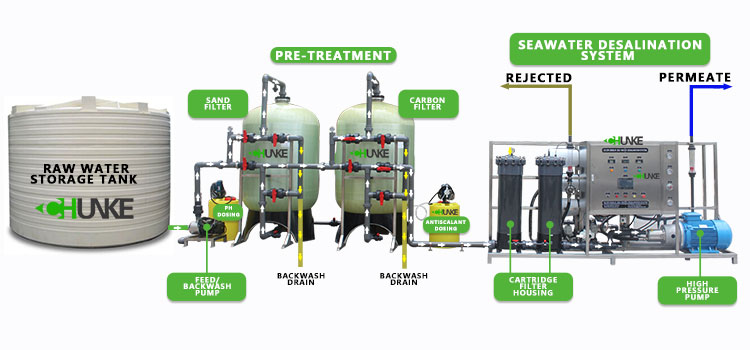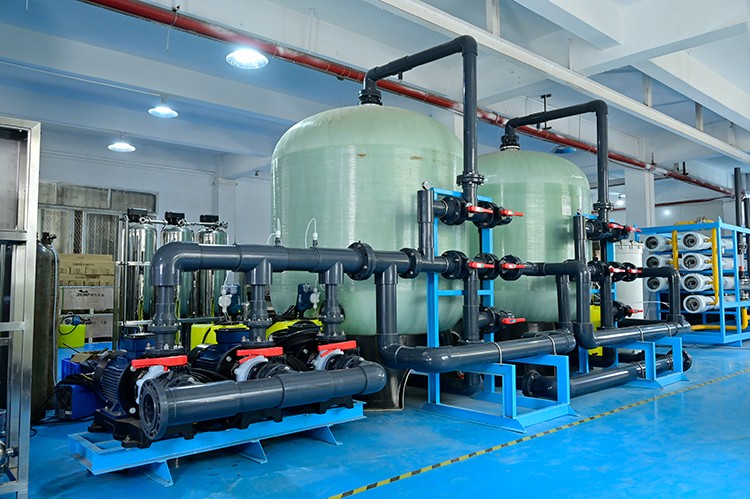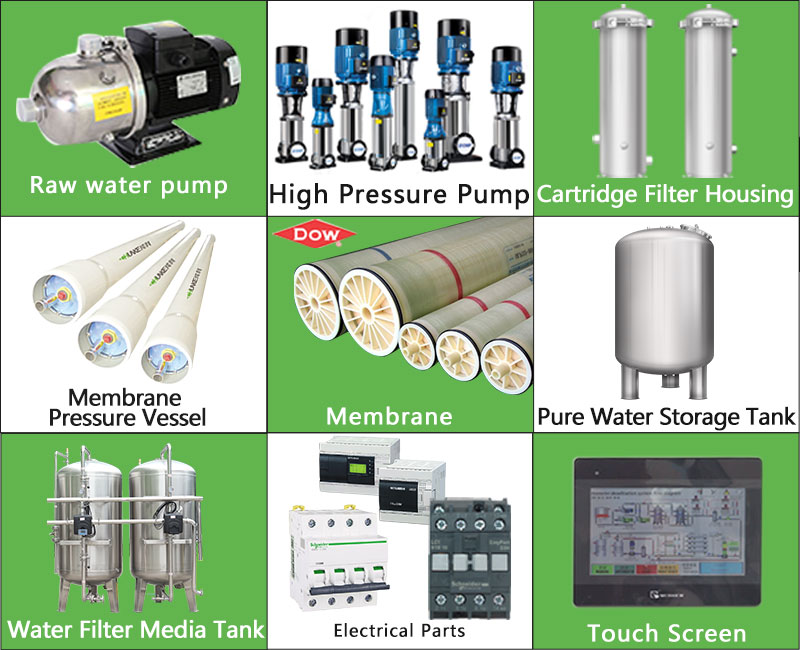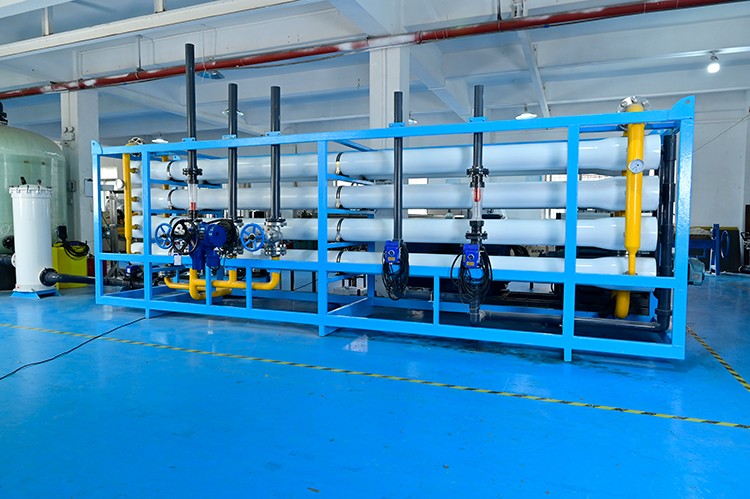What are the components of a 5000L/hour seawater desalination machine?
As the global water shortage problem becomes increasingly serious, seawater desalination technology has become one of the important means to solve the problem of fresh water supply. Especially in coastal cities and arid areas, the demand for seawater desalination equipment continues to grow.
This article will explore in depth the components of a seawater desalination machine with a water output of 5000 liters per hour and which industries need to use such equipment.

What are the components of a 5000L/hour seawater desalination machine?
Components of a 5000L/hour seawater desalination machine:
The seawater desalination machine converts seawater into drinkable fresh water through a complex process. Its main components include pretreatment system, reverse osmosis (RO) system, post-treatment system and auxiliary equipment.
1.1 Pretreatment system:
The main function of the pretreatment system is to remove suspended matter, particulate matter and some organic matter in seawater, and protect the reverse osmosis membrane from pollution and damage. The pretreatment system usually includes: multi-media filter, activated carbon filter and microfiltration or ultrafiltration membrane and other equipment.
● Multi-media filter: removes larger particles and suspended solids through media layers such as sand and carbon.
● Activated carbon filter: adsorbs organic matter and some heavy metals in seawater.
● Microfiltration or ultrafiltration membrane: further removes fine particles and microorganisms.
1.2 Reverse osmosis system:
The reverse osmosis system is the core part of the seawater desalination machine, which removes dissolved salts and most impurities in seawater through the reverse osmosis membrane. The reverse osmosis system mainly includes: high-pressure pump, reverse osmosis membrane assembly, and concentrated water discharge system.
● High-pressure pump: provides enough pressure to drive seawater through the reverse osmosis membrane, usually requiring a higher pressure (about 50-70 bar).
● Reverse osmosis membrane assembly: consists of multiple reverse osmosis membrane elements, which can effectively separate water molecules and dissolved salts.
● Concentrated water discharge system: discharges the concentrated water in the reverse osmosis process from the system, usually through a discharge pipe or a recovery system.
1.3 Post-treatment system:
The post-treatment system is used to further improve the quality of the produced water and ensure that the fresh water meets the drinking water standards. The post-treatment system may include: degassing device, pH adjustment device, mineral addition device.
● Degassing device: removes dissolved gases in water, such as carbon dioxide, ammonia, etc.
● pH adjustment device: adjust the pH value of the produced water by adding acid or alkali to prevent unstable water quality.
● Mineral addition device: In some applications, it may be necessary to add an appropriate amount of minerals to the produced water to improve the taste and nutrition.
1.4 Auxiliary equipment:
In addition to the above main systems, the seawater desalination machine also requires some auxiliary equipment to ensure the stable operation and management of the system:
● Control system: including PLC or DCS system, which is used to monitor and control the operating parameters of the entire seawater desalination machine.
● Power system: provides the power required for the operation of the seawater desalination machine, including transformers, distribution cabinets, etc.
● Pipes and valves: connect and control the fluid transportation between various systems to ensure the stability and safety of the water flow.

Which industries need to use 5000L/hour seawater desalination machine?
The wide application of seawater desalination equipment has solved the problem of fresh water supply for many industries, especially in coastal cities and islands, industrial water, offshore operations, agriculture and irrigation, beverage and food industries, emergency rescue and post-disaster reconstruction.
2.1 Coastal cities and islands:
In coastal cities and islands, fresh water resources are relatively scarce, and seawater desalination equipment has become an important source of fresh water. 5000L/hour seawater desalination machine can provide stable drinking water and domestic water for small and medium-sized communities, resorts and tourist attractions.
2.2 Industrial water:
Many industrial processes require a large amount of pure water, such as power plants, chemical plants and pharmaceutical plants. Seawater desalination equipment can provide these industrial enterprises with high-quality process water and cooling water, reduce dependence on natural fresh water resources, and reduce environmental impact.
2.3 Offshore operations:
Offshore oil drilling platforms, offshore wind farms and marine scientific research vessels need to operate at sea for a long time, and fresh water supply is an important issue. The 5000L/hour seawater desalination machine can meet the daily water needs of these operating platforms and ships, ensuring that the lives and work of personnel are not affected by the shortage of fresh water.
2.4 Agriculture and irrigation:
In arid and semi-arid areas, agricultural irrigation has a great demand for fresh water resources. Seawater desalination equipment can provide reliable irrigation water for these areas, promote agricultural production, and ensure food security.
2.5 Beverage and food industry:
The beverage and food industries have high requirements for water quality and usually require high-purity production water. Seawater desalination equipment can provide pure water that meets standards, ensuring product quality and safety while reducing dependence on traditional freshwater resources.
2.6 Emergency rescue and post-disaster reconstruction:
In natural disasters and emergencies, such as earthquakes, floods, and typhoons, traditional freshwater supply systems may be damaged. Portable or mobile seawater desalination equipment can be quickly deployed to provide emergency drinking water and domestic water to support post-disaster reconstruction.

Future development trend of seawater desalination equipment
With the continuous advancement of technology and the increase in demand, the development of seawater desalination equipment presents the following trends:
3.1 Improve energy efficiency:
The high energy consumption of the seawater desalination process has become one of the main factors restricting its large-scale application. In the future, by optimizing the reverse osmosis membrane material, improving the efficiency of the high-pressure pump and developing new energy recovery technologies, the energy consumption of seawater desalination equipment can be significantly reduced and the overall energy efficiency can be improved.
3.2 Reduce costs:
At present, the manufacturing and operating costs of seawater desalination equipment are still high. Through technological innovation and large-scale production, the equipment cost and operating expenses can be gradually reduced, making seawater desalination a more economical and feasible water resource solution.
3.3 Enhance anti-pollution ability:
Organic matter, suspended matter and microorganisms in seawater can pollute the reverse osmosis membrane and affect the operating efficiency and life of the equipment. In the future, by developing new anti-pollution membrane materials and optimizing pretreatment processes, the anti-pollution ability of the reverse osmosis membrane can be improved and the service life of the equipment can be extended.
3.4 Promote distributed systems:
Although traditional large-scale seawater desalination plants have a large water output, they have a long construction period and high investment costs. Distributed seawater desalination systems have the advantages of high flexibility and short construction period, and can be flexibly deployed according to demand, which is particularly suitable for islands, coastal villages and towns, and emergency rescue scenarios.
3.5 Application of new energy:
With the development of new energy technologies, the application of clean energy such as solar energy and wind energy to seawater desalination equipment can reduce energy consumption and carbon emissions, and promote the sustainable development of seawater desalination technology.

Conclusion on 5000L/hour seawater desalination machine
The 5000L/hour seawater desalination machine consists of a pretreatment system, a reverse osmosis system, a post-treatment system and auxiliary equipment, and is an important equipment for solving the problem of freshwater resource shortage. It is widely used in coastal cities, industries, offshore operations, agricultural irrigation, beverage and food industries, and emergency rescue.




